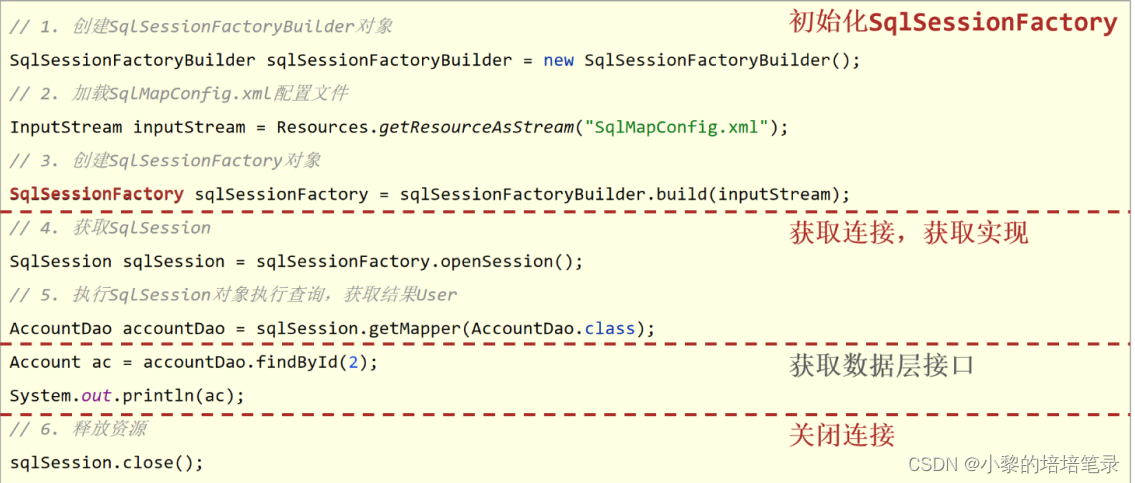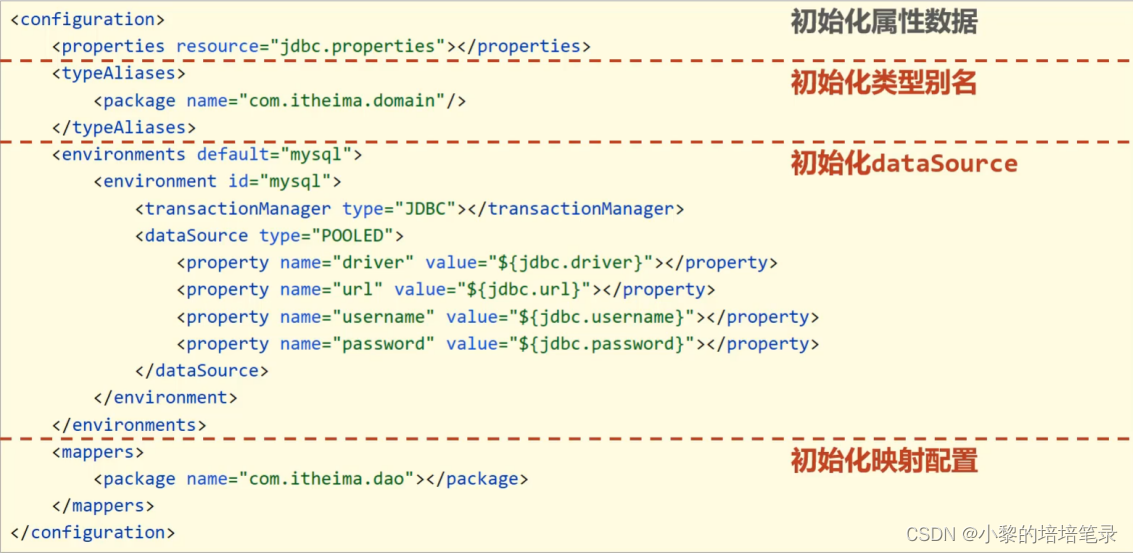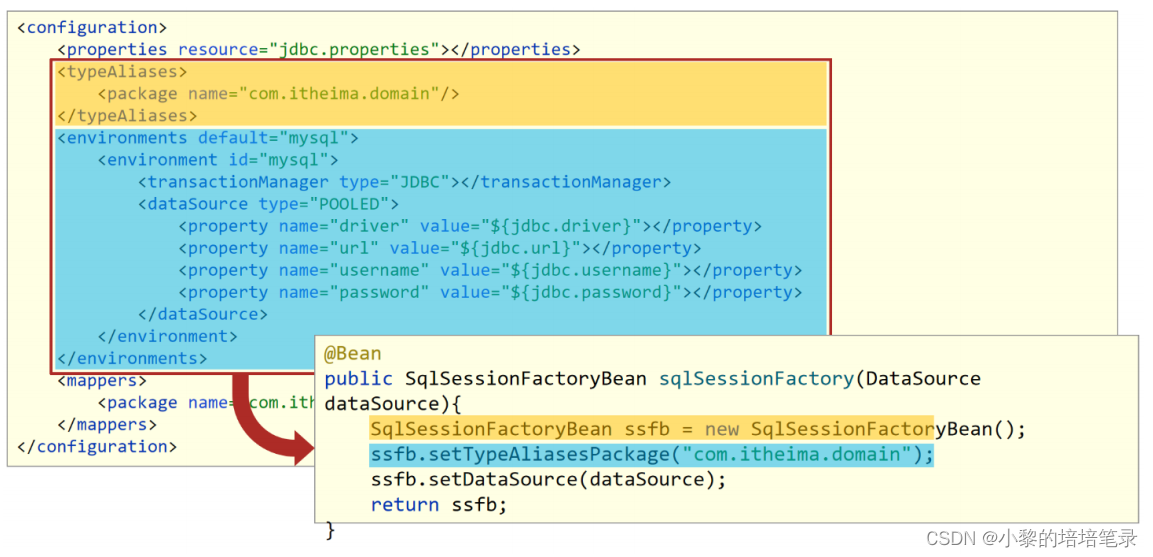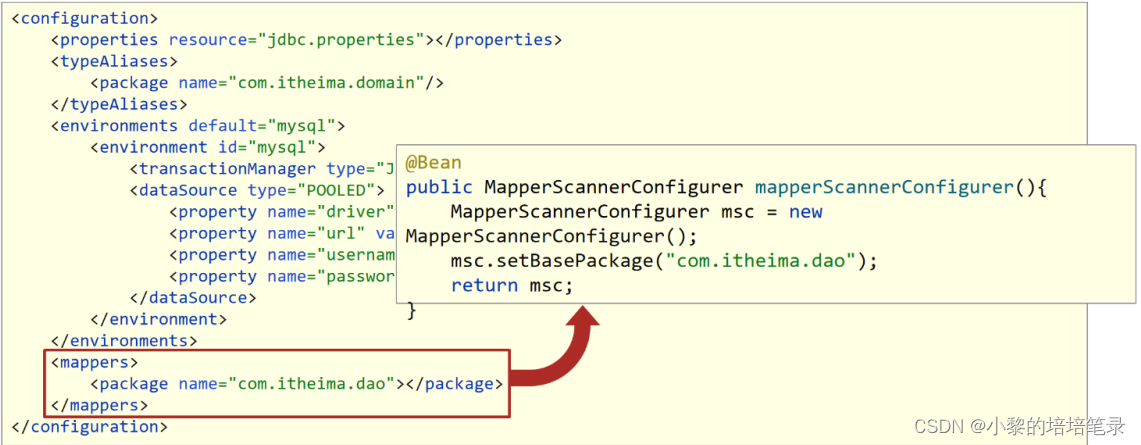一、环境准备
1、Mybatis 环境
▶ 步骤1 : 准备数据库表
Mybatis是来操作数据库表,所以先创建一个数据库及表
create database spring_db character set utf8; use spring_db; create table tbl_account( id int primary key auto_increment, name varchar(35), money double );▶ 步骤2 : 创建项目导入jar包
项目的pom.xml添加相关依赖
<dependencies> <dependency> <groupId>org.springframework</groupId> <artifactId>spring-context</artifactId> <version>5.2.10.RELEASE</version> </dependency> <dependency> <groupId>com.alibaba</groupId> <artifactId>druid</artifactId> <version>1.1.16</version> </dependency> <dependency> <groupId>org.mybatis</groupId> <artifactId>mybatis</artifactId> <version>3.5.6</version> </dependency> <dependency> <groupId>mysql</groupId> <artifactId>mysql-connector-java</artifactId> <version>5.1.47</version> </dependency> </dependencies>▶ 步骤3 : 根据表创建模型类
public class Account implements Serializable { private Integer id; private String name; private Double money; //同时给出setter...getter...toString...方法略 }▶ 步骤4 : 创建Dao接口
public interface AccountDao { @Insert("insert into tbl_account(name,money)values(#{name},#{money})") void save(Account account); @Delete("delete from tbl_account where id = #{id} ") void delete(Integer id); @Update("update tbl_account set name = #{name} , money = #{money} where id = #{id} ") void update(Account account); @Select("select * from tbl_account") List<Account> findAll(); @Select("select * from tbl_account where id = #{id} ") Account findById(Integer id); }▶ 步骤5 : 创建Service接口和实现类
public interface AccountService { void save(Account account); void delete(Integer id); void update(Account account); List<Account> findAll(); Account findById(Integer id); } @Service public class AccountServiceImpl implements AccountService { @Autowired private AccountDao accountDao; public void save(Account account) { accountDao.save(account); } public void update(Account account){ accountDao.update(account); } public void delete(Integer id) { accountDao.delete(id); } public Account findById(Integer id) { return accountDao.findById(id); } public List<Account> findAll() { return accountDao.findAll(); } }▶ 步骤6 : 添加jdbc.properties文件
resources目录下添加,用于配置数据库连接四要素
jdbc.driver=com.mysql.jdbc.Driver jdbc.url=jdbc:mysql://localhost:3306/spring_db?useSSL=false jdbc.username=root jdbc.password=rootuseSSL : 关闭MySQL的SSL连接
▶ 步骤7 : 添加Mybatis核心配置文件
<?xml version="1.0" encoding="UTF-8"?> <!DOCTYPE configuration PUBLIC "-//mybatis.org//DTD Config 3.0//EN" "http://mybatis.org/dtd/mybatis-3-config.dtd"> <configuration> <!--读取外部properties配置文件--> <properties resource="jdbc.properties"></properties> <!--别名扫描的包路径--> <typeAliases> <package name="com.itheima.domain"/> </typeAliases> <!--数据源--> <environments default="mysql"> <environment id="mysql"> <transactionManager type="JDBC"></transactionManager> <dataSource type="POOLED"> <property name="driver" value="${jdbc.driver}"></property> <property name="url" value="${jdbc.url}"></property> <property name="username" value="${jdbc.username}"></property> <property name="password" value="${jdbc.password}"></property> </dataSource> </environment> </environments> <!--映射文件扫描包路径--> <mappers> <package name="com.itheima.dao"></package> </mappers> </configuration>▶ 步骤8 : 编写应用程序
public class App { public static void main(String[] args) throws IOException { // 1. 创建SqlSessionFactoryBuilder对象 SqlSessionFactoryBuilder sqlSessionFactoryBuilder = new SqlSessionFactoryBuilder(); // 2. 加载SqlMapConfig.xml配置文件 InputStream inputStream = Resources.getResourceAsStream("SqlMapConfig.xml.bak"); // 3. 创建SqlSessionFactory对象 SqlSessionFactory sqlSessionFactory = sqlSessionFactoryBuilder.build(inputStream); // 4. 获取SqlSession SqlSession sqlSession = sqlSessionFactory.openSession(); // 5. 执行SqlSession对象执行查询,获取结果User AccountDao accountDao = sqlSession.getMapper(AccountDao.class); Account ac = accountDao.findById(1); System.out.println(ac); // 6. 释放资源 sqlSession.close(); } }然后运行程序。
2、整合思路分析
▶ Mybatis程序核心对象分析
从图中可以获取到,真正需要交给Spring管理的是SqlSessionFactory
▶ 整合Mybatis,就是将Mybatis用到的内容交给Spring管理,分析配置文件
说明:
● 第一行读取外部properties配置文件,Spring有提供具体的解决方案
@PropertySource,需要交给Spring
● 第二行起别名包扫描,为SqlSessionFactory服务的,需要交给Spring
● 第三行主要用于做连接池,Spring之前我们已经整合了Druid连接池,这块也需要交给Spring
● 前面三行一起都是为了创建SqlSession对象用的,那么用Spring管理SqlSession对象吗?SqlSession是由SqlSessionFactory创建出来的,所以只需要将SqlSessionFactory交给Spring管理即可。
● 第四行是Mapper接口和映射文件[如果使用注解就没有该映射文件],这个是在获取到SqlSession以后执行具体操作的时候用,所以它和SqlSessionFactory创建的时机都不在同一个时间,可能需要单独管理。
二、Spring整合Mybatis
▶ 步骤1 : 项目中导入整合需要的jar包
<dependency> <!--Spring操作数据库需要该jar包--> <groupId>org.springframework</groupId> <artifactId>spring-jdbc</artifactId> <version>5.2.10.RELEASE</version> </dependency> <dependency> <!-- Spring与Mybatis整合的jar包 这个jar包mybatis在前面,是Mybatis提供的 --> <groupId>org.mybatis</groupId> <artifactId>mybatis-spring</artifactId> <version>1.3.0</version> </dependency>▶ 步骤2 : 创建Spring的主配置类
//配置类注解 @Configuration //包扫描,主要扫描的是项目中的AccountServiceImpl类 @ComponentScan("com.itheima") public class SpringConfig { }▶ 步骤3 : 创建数据源的配置类
在配置类中完成数据源的创建
public class JdbcConfig { @Value("${jdbc.driver}") private String driver; @Value("${jdbc.url}") private String url; @Value("${jdbc.username}") private String userName; @Value("${jdbc.password}") private String password; @Bean public DataSource dataSource(){ DruidDataSource ds = new DruidDataSource(); ds.setDriverClassName(driver); ds.setUrl(url); ds.setUsername(userName); ds.setPassword(password); return ds; } }** ▶ 步骤4 : 主配置类中读properties并引入数据源配置类**
@Configuration @ComponentScan("com.itheima") @PropertySource("classpath:jdbc.properties") @Import(JdbcConfig.class) public class SpringConfig { }▶ 步骤5 : 创建Mybatis配置类并配置SqlSessionFactory
public class MybatisConfig { //定义bean,SqlSessionFactoryBean,用于产生SqlSessionFactory对象 @Bean public SqlSessionFactoryBean sqlSessionFactory(DataSource dataSource){ SqlSessionFactoryBean ssfb = new SqlSessionFactoryBean(); //设置模型类的别名扫描 ssfb.setTypeAliasesPackage("com.itheima.domain"); //设置数据源 ssfb.setDataSource(dataSource); return ssfb; } //定义bean,返回MapperScannerConfigurer对象 @Bean public MapperScannerConfigurer mapperScannerConfigurer(){ MapperScannerConfigurer msc = new MapperScannerConfigurer(); msc.setBasePackage("com.itheima.dao"); return msc; } }说明:
● 使用SqlSessionFactoryBean封装SqlSessionFactory需要的环境信息
○ SqlSessionFactoryBean是前面我们讲解FactoryBean的一个子类,在该类中将SqlSessionFactory的创建进行了封装,简化对象的创建,我们只需要将其需要的内容设置即可。
○ 方法中有一个参数为dataSource,当前Spring容器中已经创建了Druid数据源,类型刚好是DataSource类型,此时在初始化SqlSessionFactoryBean这个对象的时候,发现需要使用DataSource对象,而容器中刚好有这么一个对象,就自动加载了DruidDataSource对象。● 使用MapperScannerConfigurer加载Dao接口,创建代理对象保存到IOC容器中
○ 这个MapperScannerConfigurer对象也是MyBatis提供的专用于整合的jar包中的类,用来处理原始配置文件中的mappers相关配置,加载数据层的Mapper接口类
○ MapperScannerConfigurer有一个核心属性basePackage,就是用来设置所扫描的包路径▶ 步骤6 : 主配置类中引入Mybatis配置类
@Configuration @ComponentScan("com.itheima") @PropertySource("classpath:jdbc.properties") @Import({JdbcConfig.class,MybatisConfig.class}) public class SpringConfig { }▶ 步骤7 : 编写运行类
在运行类中,从IOC容器中获取Service对象,调用方法获取结果
public class App2 { public static void main(String[] args) { ApplicationContext ctx = new AnnotationConfigApplicationContext(SpringConfig.class); AccountService accountService = ctx.getBean(AccountService.class); Account ac = accountService.findById(1); System.out.println(ac); } }▶ 步骤8 : 运行程序
三、Spring整合Junit
● @RunWith
● @ContextConfiguration
基础环境和前面的环境一样
▶ 步骤1 : pom.xml引入依赖
<dependency> <groupId>junit</groupId> <artifactId>junit</artifactId> <version>4.12</version> <scope>test</scope> </dependency> <dependency> <groupId>org.springframework</groupId> <artifactId>spring-test</artifactId> <version>5.2.10.RELEASE</version> </dependency>▶ 步骤2 : 编写测试类
在test\java下创建一个AccountServiceTest,这个名字任意
//设置类运行器 @RunWith(SpringJUnit4ClassRunner.class) //设置Spring环境对应的配置类 @ContextConfiguration(classes = {SpringConfiguration.class}) //加载配置类 //@ContextConfiguration(locations={"classpath:applicationContext.xml"})//加载配置文件 public class AccountServiceTest { //支持自动装配注入bean @Autowired private AccountService accountService; @Test public void testFindById(){ System.out.println(accountService.findById(1)); } @Test public void testFindAll(){ System.out.println(accountService.findAll()); } }注意:
▶ 单元测试,如果测试的是注解配置类,则使用
@ContextConfiguration(classes = 配置类.class)
▶ 单元测试,如果测试的是配置文件,则使用@ContextConfiguration(locations={配置文件名,...})
▶ Junit运行后是基于Spring环境运行的,所以Spring提供了一个专用的类运行器,这个务必要设置,这个类运行器就在Spring的测试专用包中提供的,导入的坐标就是这个东西SpringJUnit4ClassRunner
▶ 上面两个配置都是固定格式,当需要测试哪个bean时,使用自动装配加载对应的对象,下面的工作就和以前做Junit单元测试完全一样了
版权归原作者 小黎的培培笔录 所有, 如有侵权,请联系我们删除。






